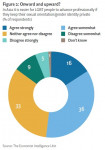Economic synergies and changing risk appetites are driving expanded Gulf investment into Asia, according to Economist Intelligence Unit report
Several trends have underpinned the rising interest from investors in the Gulf Co-operation Council (GCC) countries in Asian assets:
● Changing investment preferences in the Gulf: In previous oil
booms most of the billions of dollars in Gulf capital were parked in the international banking system and US treasuries, and the rest invested cautiously in portfolios that tended to favour capital preservation over yield maximisation. But that has now changed. "What we are seeing today is that GCC sovereigns are increasingly managing their own surpluses directly, rather than outsourcing that process," says Matthew Shinkman, editor of the report. "At the same time, the past decade has witnessed rising sophistication in the GCC investment community, and deepening integration of emerging markets into the world economy, which have also underpinned a growing appetite among GCC investors for Asian assets."
● Changes in Asia making investment in the region more attractive:
Asian countries have made substantial progress in recent years in liberalising their capital accounts, strengthening their business environments and improving conditions for foreign investors. Real GDP growth in the region has also been robust over the past five years, and growth has in part been driven by big, long-term public investment programmes, which have opened up a wide new array of opportunities for Gulf investors. "For our investors, we believe that the mature markets of Europe and the US will remain very important components of their investment portfolios. But introducing opportunities from the growing economies to the East is a natural way for us to offer them further diversification within their investment holdings," says Atif Abdulmalik, CEO of Arcapita.
● Significant strengthening of links between the GCC and Asia: In
the past five years trade volumes between the GCC and Asia have tripled, and without question much of the incremental demand for Gulf exports going forward-not just oil and gas but also petrochemicals, base metals, and services like finance and tourism-will come from Asia. The GCC region has seen large inflows of migrant labour from the region, creating both a growing source of private capital flows between the regions, but also an increased cultural overlap.
● Geopolitical trends favour strategic diversification:
Traditionally the Gulf states have aligned themselves closely with the US, for both economic and strategic reasons. This will remain the case over the short term, but over the longer term the region’s increased interest in Asia is a natural extension of its aim to diversify the nature of its economic activity, and a recognition that future relationships with the leading Asian nations will take on major strategic importance, should current economic and consumption trends continue over the medium term.
Near East meets Far East: the rise of Gulf investment in Asia is available free of charge at: www.eiu.com/gulfinvestment
웹사이트: http://www.eiu.com
연락처
Edgar Fernandez
Marketing Manager, Asia-Pacific
(852) 2585 3826 이메일 보내기
Fax: (852) 2802 7007
이 보도자료는 Economist Intelligence Unit가(이) 작성해 뉴스와이어 서비스를 통해 배포한 뉴스입니다.




